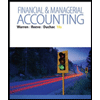
Concept explainers
1.
Cash dividends: The amount of cash provided by a corporation out of its distributable profits to its shareholders as a return for the amount invested by them is referred as cash dividends.
Common stock: These are the ordinary shares that a corporation issues to the investors in order to raise funds. In return, the investors receive a share of profit from the profits earned by the corporation.
Preferred stock: The stock that provides a fixed amount of return (dividend) to its stockholder before paying dividends to common stockholders is referred to preferred stock.
To determine: the dividend paid to non-cumulative preferred stockholders and common stockholders.
2.
the dividend paid to non-cumulative preferred stockholders and common stockholders.
3.
the dividend paid to cumulative preferred stockholders and common stockholders.
Want to see the full answer?
Check out a sample textbook solution
Chapter 11 Solutions
Bundle: Financial Accounting: Tools for Business Decision Making 8e Binder Ready Version + WileyPLUS Registration Code
- I am searching for a clear explanation of this financial accounting problem with valid methods.arrow_forwardWhat is the answer?arrow_forwardAt the end of the current year, the owners'equity in Beacon Co. is now $425,000. During the year, the assets of the business had increased by $93,000 and the liabilities had increased by $156,000. What must Owners' equity at the beginning of the year have been?arrow_forward
- Management is considering the following independent courses of action to increase net incomearrow_forwardThe Riverfront has sales of $875,600, costs of goods sold of $623,800, inventory of $152,700, and accounts receivable of $85,400. How many days, on average, does it take the firm to sell its inventory assuming that all sales are on credit? A) 79.52 days B) 89.25 days C) 82.94 days D) 91.45 days E) 80.31 daysarrow_forwardBella's has annual sales of $528,400, total debt of $112,000, total equity of $145,000, and a profit margin of 7.54 percent. What is the return on assets? A) 12.67 percent B) 14.85 percent C) 10.43 percent D) 13.52 percent E) 18.92 percentarrow_forward
 Intermediate Accounting: Reporting And AnalysisAccountingISBN:9781337788281Author:James M. Wahlen, Jefferson P. Jones, Donald PagachPublisher:Cengage Learning
Intermediate Accounting: Reporting And AnalysisAccountingISBN:9781337788281Author:James M. Wahlen, Jefferson P. Jones, Donald PagachPublisher:Cengage Learning Excel Applications for Accounting PrinciplesAccountingISBN:9781111581565Author:Gaylord N. SmithPublisher:Cengage Learning
Excel Applications for Accounting PrinciplesAccountingISBN:9781111581565Author:Gaylord N. SmithPublisher:Cengage Learning Financial & Managerial AccountingAccountingISBN:9781285866307Author:Carl Warren, James M. Reeve, Jonathan DuchacPublisher:Cengage Learning
Financial & Managerial AccountingAccountingISBN:9781285866307Author:Carl Warren, James M. Reeve, Jonathan DuchacPublisher:Cengage Learning Financial Accounting: The Impact on Decision Make...AccountingISBN:9781305654174Author:Gary A. Porter, Curtis L. NortonPublisher:Cengage Learning
Financial Accounting: The Impact on Decision Make...AccountingISBN:9781305654174Author:Gary A. Porter, Curtis L. NortonPublisher:Cengage Learning Financial AccountingAccountingISBN:9781305088436Author:Carl Warren, Jim Reeve, Jonathan DuchacPublisher:Cengage Learning
Financial AccountingAccountingISBN:9781305088436Author:Carl Warren, Jim Reeve, Jonathan DuchacPublisher:Cengage Learning




